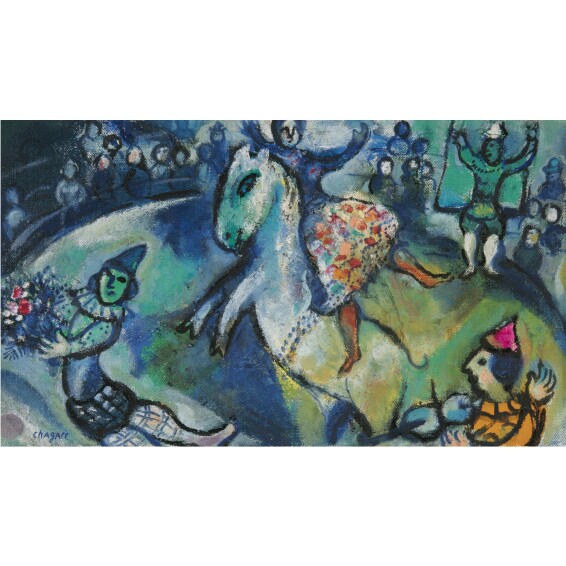- 110
Marc Chagall
Description
- Marc Chagall
- Scène de Cirque
- signed Chagall (lower left); signed Marc, dated 1958 and dedicated Pour Vava on the reverse
- oil on canvas
- 24 by 41cm., 9 1/2 by 16 1/8 in.
Provenance
Acquired from the above by the present owner
The authenticity of this work has been confirmed by the Comité Chagall.
Condition
"In response to your inquiry, we are pleased to provide you with a general report of the condition of the property described above. Since we are not professional conservators or restorers, we urge you to consult with a restorer or conservator of your choice who will be better able to provide a detailed, professional report. Prospective buyers should inspect each lot to satisfy themselves as to condition and must understand that any statement made by Sotheby's is merely a subjective, qualified opinion. Prospective buyers should also refer to any Important Notices regarding this sale, which are printed in the Sale Catalogue.
NOTWITHSTANDING THIS REPORT OR ANY DISCUSSIONS CONCERNING A LOT, ALL LOTS ARE OFFERED AND SOLD AS IS" IN ACCORDANCE WITH THE CONDITIONS OF BUSINESS PRINTED IN THE SALE CATALOGUE."
Catalogue Note
Dedicated to his second wife Vava (Valentina Brodsky), the present work is an exceptionally dynamic and vibrant depiction of the circus, one of Chagall's most celebrated subjects. The circus was a continuous source of inspiration for the artist throughout his life: a magical dreamland that transported him into the parallel world of the subconscious. This fascination dates back to his childhood in Vitebsk and indeed he also frequently attended the circus in Paris with Ambroise Vollard. The circular ring was certainly suited to the dynamic atmosphere that is such a dominant feature across all of his œuvre, and indeed the viewer is thrust into the centre of the drama to take a seat in the audience. In the artist's own words, 'it is a magic world, the circus, a timeless dancing game where tears and smiles, the play of arms and legs take the form of a great art' (quoted in Le Cirque (exhibition catalogue), Pierre Matisse Gallery, New York, 1981, n.p.).
Scène de Cirque combines many of Chagall's most iconic artistic elements: the bold palette, the flowers, the horse, and even a violin player. The characteristic blue background gives the work a wonderfully dramatic atmosphere, which shows off the vibrant areas of yellows, pinks, greens and oranges to great effect. The thick application of paint on the bouquet of flowers is echoed by the equally physical execution of the horse-riding woman's skirt. The scene is imbued with a palpable energy and buzz, deriving from the circus's ambiguous identity as simultaneously fun-loving and tragic. The work - with its lively cast of animals, clowns, musicians and acrobats - is extraordinarily emotive and life-affirming, just as any visit to the circus should be. As Venturi explains, 'the importance of the circus motif in modern French literature and painting is well known; in painting it suffices to recall the names of Seurat and Rouault. As always, Chagall's images of circus people [...] are at once burlesque and tender. Their perspective of sentiment, their fantastic forms, suggest that the painter is amusing himself in a freer mood than usual; and the result is eloquent of the unmistakable purity flowing from Chagall's heart. These circus scenes are mature realisations of earlier dreams' (Lionello Venturi, Marc Chagall, New York, 1945, p. 39).

